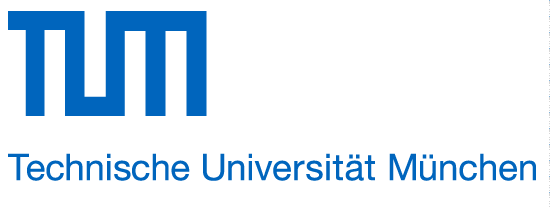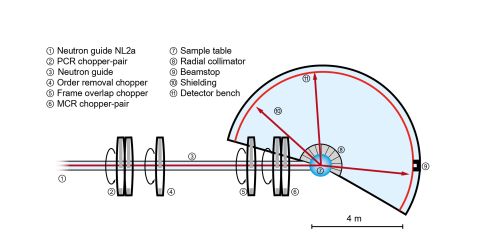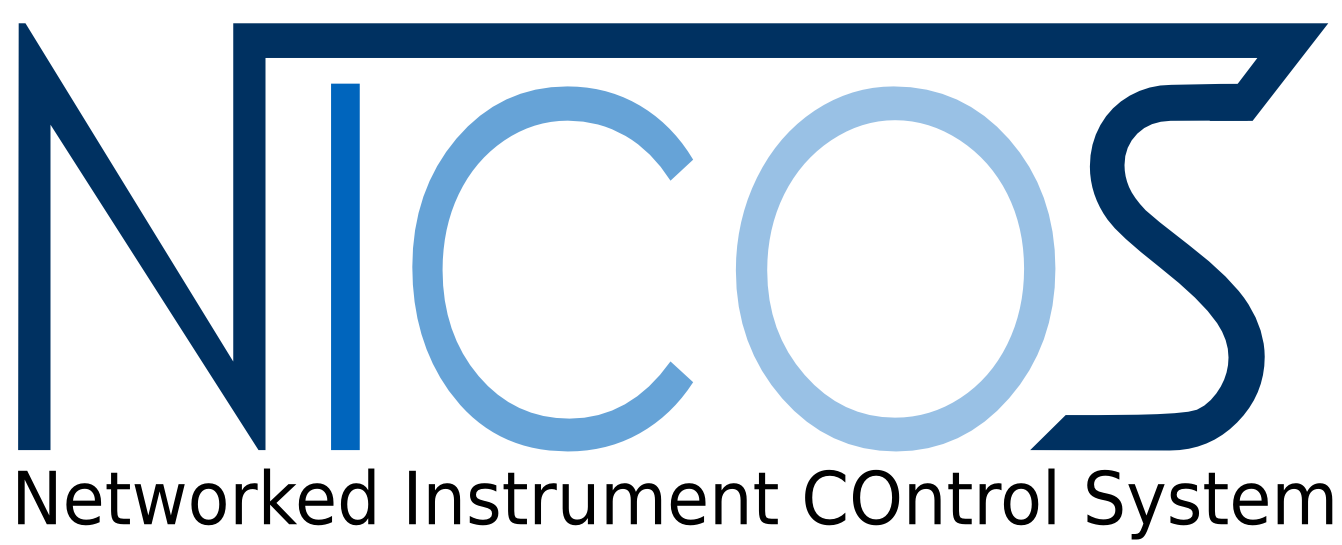MLZ is a cooperation between:
 > Technische Universität München
> Technische Universität München > Helmholtz-Zentrum Hereon
> Helmholtz-Zentrum Hereon
 > Forschungszentrum Jülich
> Forschungszentrum Jülich
MLZ is a member of:
 > LENS
> LENS > ERF-AISBL
> ERF-AISBL
MLZ on social media:

MLZ (eng)
Lichtenbergstr.1
85748 Garching
TOFTOF
Cold neutron time-of-flight spectrometer
This instrument is focussed on cold neutrons. All parameters given here are valid during the current operation of FRM II. Please get in touch with the instrument team well in advance for all further details (length of experiment etc.).
TOFTOF is a direct geometry disc-chopper time-of-flight spectrometer located in the Neutron Guide Hall West. It offers an excellent signal-to-background ratio and a variable energy resolution. Adaptable for a wide range of sample environments, TOFTOF is ideal for investigations of fundamental concepts and challenges in physics and materials science.
TOFTOF is suitable for both inelastic and quasi-elastic neutron scattering and the scientific questions addressed range from the dynamics in disordered materials in hard and soft condensed matter systems (such as polymer melts, glasses, molecular liquids, or liquid metal alloys), properties of new hydrogen storage materials to low-energy magnetic excitations in multiferroic compounds, and molecular magnets.
A cascade of seven fast rotating disc choppers which are housed in four chopper vessels is used to prepare a monochromatic pulsed beam which is focussed onto the sample by a converging supermirror section. The scattered neutrons are detected by 1000 3He detector tubes with a time resolution up to 50 ns. The detectors are mounted at a distance of 4 m and cover 12 m2 (or 0.75 sr). The high rotation speed of the chopper system (up to 22 000 rpm) together with a wavelength range of 1.4 -~5 Å allows free tuning of the energy resolution between 3 meV and ~100 µeV.
The prototype of a new focussing neutron guide has been installed recently, as alternative option in the last section of the guide system. The existing linearly tapered neutron guide yields a beam spot size of 23 × 47 mm2. Using the focussing guide, an intensity gain up to a factor of 3 (wavelength dependent) is observed on a sample area of 10 × 10 mm2.
- Diffusion in liquid metals and alloys
- Hydrogen dynamics in soft matter systems such as molecular liquids, polymer melts or colloids
- Molecular magnetism, quantum criticality in heavy fermion compounds, low energy excitations in multiferroic materials and novel magnetic phases
- Dynamic properties of energy storage materials, such as solid state hydrogen storage materials, electrolytes for batteries and fuel cells, or gas storage materials
- Energy-resolved quasi-elastic neutron scattering on proteins, vesicles, and biological materials
- Kinetic studies of hydrogen binding, e.g. in concrete
- Aging effects in disordered media and low frequency dynamics in glasses
- Biological activity and functionality of proteins and cells under pressure
- CCR Cryostat (4 – 600 K)
- 3He insertion device (down to 0.5 K)
- Circulation thermostat furnace (255 – 450 K)
- High temperature furnace (300 – 2100 K)
- 2.5 T magnet
- Electromagnetic levitator
- Electrostatic levitator
- Hydraulic pressure cells (up to 3.5 kbar)
- Clamp pressure cells (few GPa)
- In-situ raman spectroscopy (in combination with neutron spectroscopy)
- Neutron guide: NL2a-u
- Number of chopper discs: 7
- Chopper frequency range: 400 min-1 – 22000 min-1
- Diameter of chopper disc: 600 mm
- Cross section of neutron guide
- at the entrance: 44 × 100 mm2
- 20 cm in front of sample position: 23 × 47 mm2
- Cross section of focussing guide: minimal 12 × 25 mm2
- Adjustable range of incident neutrons: 1.4 – ~5 Å
- Elastic energy resolution: ~100 µeV – 3 meV
- Range of energy transfers: -30 meV – 50 meV
- Angular range of the detector bank: -15° to -7° and 7° to 140°
Instrument Scientists
Dr. Marcell Wolf
Phone: +49 (0)89 289-14881
E-Mail: marcell.wolf@frm2.tum.de
Dr. Christopher Garvey
Phone: +49 (0)89 289-12697
E-Mail: christopher.garvey@frm2.tum.de
TOFTOF
Phone: +49 (0)89 289-14881
Operated by

Publications
Find the latest publications regarding TOFTOF in our publication database iMPULSE:
Citation of the instrument
Heinz Maier-Leibnitz Zentrum. (2015). TOFTOF: Cold neutron time-of-flight spectrometer. Journal of large-scale research facilities, 1, A15. http://dx.doi.org/10.17815/jlsrf-1-40
For citation please always include the DOI.
Instrument control
Gallery




MLZ is a cooperation between:
 > Technische Universität München
> Technische Universität München > Helmholtz-Zentrum Hereon
> Helmholtz-Zentrum Hereon
 > Forschungszentrum Jülich
> Forschungszentrum Jülich
MLZ is a member of:
 > LENS
> LENS > ERF-AISBL
> ERF-AISBL
MLZ on social media:





